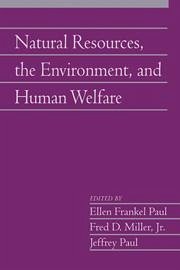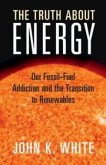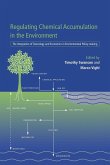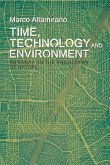Natural Resources, the Environment, and Human Welfare: Volume 26, Part 2
Herausgeber: Paul, Ellen Frankel; Paul, Jeffrey; Miller Jr, Fred D
Natural Resources, the Environment, and Human Welfare: Volume 26, Part 2
Herausgeber: Paul, Ellen Frankel; Paul, Jeffrey; Miller Jr, Fred D
- Broschiertes Buch
- Merkliste
- Auf die Merkliste
- Bewerten Bewerten
- Teilen
- Produkt teilen
- Produkterinnerung
- Produkterinnerung
Do environmental problems need government controls or can we find solutions by harnessing the incentives of the free market?
Andere Kunden interessierten sich auch für
![The Truth about Energy The Truth about Energy]() John K WhiteThe Truth about Energy46,99 €
John K WhiteThe Truth about Energy46,99 €![Regulating Chemical Accumulation in the Environment Regulating Chemical Accumulation in the Environment]() Regulating Chemical Accumulation in the Environment47,99 €
Regulating Chemical Accumulation in the Environment47,99 €![The Soviet Environment The Soviet Environment]() The Soviet Environment42,99 €
The Soviet Environment42,99 €![Time, Technology and Environment Time, Technology and Environment]() Marco AltamiranoTime, Technology and Environment30,99 €
Marco AltamiranoTime, Technology and Environment30,99 €![Anarchy and the Environment Anarchy and the Environment]() Anarchy and the Environment33,99 €
Anarchy and the Environment33,99 €![Rebuilding the Unity of Health and the Environment Rebuilding the Unity of Health and the Environment]() Institute Of MedicineRebuilding the Unity of Health and the Environment28,99 €
Institute Of MedicineRebuilding the Unity of Health and the Environment28,99 €![The Fragile Earth The Fragile Earth]() David RemnickThe Fragile Earth15,99 €
David RemnickThe Fragile Earth15,99 €-
-
-
Do environmental problems need government controls or can we find solutions by harnessing the incentives of the free market?
Produktdetails
- Produktdetails
- Verlag: Cambridge University Press
- Seitenzahl: 442
- Erscheinungstermin: 27. September 2010
- Englisch
- Abmessung: 226mm x 152mm x 23mm
- Gewicht: 576g
- ISBN-13: 9780521139748
- ISBN-10: 0521139740
- Artikelnr.: 32733685
- Herstellerkennzeichnung
- Libri GmbH
- Europaallee 1
- 36244 Bad Hersfeld
- gpsr@libri.de
- Verlag: Cambridge University Press
- Seitenzahl: 442
- Erscheinungstermin: 27. September 2010
- Englisch
- Abmessung: 226mm x 152mm x 23mm
- Gewicht: 576g
- ISBN-13: 9780521139748
- ISBN-10: 0521139740
- Artikelnr.: 32733685
- Herstellerkennzeichnung
- Libri GmbH
- Europaallee 1
- 36244 Bad Hersfeld
- gpsr@libri.de
1. Liberty, property, environmentalism Carol M. Rose; 2. Who is the
invader? Alien species, property rights, and the police power Mark Sagoff;
3. Politics and property in natural resources Andrew P. Morriss; 4. Two
theories of environmental regulation John Hasnas; 5. The end of the
externality revolution A. H. Barnett and Bruce Yandle; 6. Freedom and
dependency in an environmental age Andrew Dobson; 7. The call of nature
Charles T. Rubin; 8. Do global warming and climate change represent a
serious threat to our welfare and environment? Michael E. Mann; 9. History,
politics, and claims of man-made global warming John David Lewis; 10.
Suppressing liberty, censoring information, wasting resources, and calling
it good for the environment J. R. Clark and Dwight R. Lee; 11. Taking
property rights seriously: the case of climate change Jonathan H. Adler;
12. Should endangered species have standing? Towards legal rights for
listed species J. Baird Callicott and William Grove-Fanning; 13. The
Endangered Species Act, regulatory takings, and public goods N. Scott
Arnold; 14. Understanding the precautionary principle and its threat to
human welfare H. Sterling Burnett.
invader? Alien species, property rights, and the police power Mark Sagoff;
3. Politics and property in natural resources Andrew P. Morriss; 4. Two
theories of environmental regulation John Hasnas; 5. The end of the
externality revolution A. H. Barnett and Bruce Yandle; 6. Freedom and
dependency in an environmental age Andrew Dobson; 7. The call of nature
Charles T. Rubin; 8. Do global warming and climate change represent a
serious threat to our welfare and environment? Michael E. Mann; 9. History,
politics, and claims of man-made global warming John David Lewis; 10.
Suppressing liberty, censoring information, wasting resources, and calling
it good for the environment J. R. Clark and Dwight R. Lee; 11. Taking
property rights seriously: the case of climate change Jonathan H. Adler;
12. Should endangered species have standing? Towards legal rights for
listed species J. Baird Callicott and William Grove-Fanning; 13. The
Endangered Species Act, regulatory takings, and public goods N. Scott
Arnold; 14. Understanding the precautionary principle and its threat to
human welfare H. Sterling Burnett.
1. Liberty, property, environmentalism Carol M. Rose; 2. Who is the
invader? Alien species, property rights, and the police power Mark Sagoff;
3. Politics and property in natural resources Andrew P. Morriss; 4. Two
theories of environmental regulation John Hasnas; 5. The end of the
externality revolution A. H. Barnett and Bruce Yandle; 6. Freedom and
dependency in an environmental age Andrew Dobson; 7. The call of nature
Charles T. Rubin; 8. Do global warming and climate change represent a
serious threat to our welfare and environment? Michael E. Mann; 9. History,
politics, and claims of man-made global warming John David Lewis; 10.
Suppressing liberty, censoring information, wasting resources, and calling
it good for the environment J. R. Clark and Dwight R. Lee; 11. Taking
property rights seriously: the case of climate change Jonathan H. Adler;
12. Should endangered species have standing? Towards legal rights for
listed species J. Baird Callicott and William Grove-Fanning; 13. The
Endangered Species Act, regulatory takings, and public goods N. Scott
Arnold; 14. Understanding the precautionary principle and its threat to
human welfare H. Sterling Burnett.
invader? Alien species, property rights, and the police power Mark Sagoff;
3. Politics and property in natural resources Andrew P. Morriss; 4. Two
theories of environmental regulation John Hasnas; 5. The end of the
externality revolution A. H. Barnett and Bruce Yandle; 6. Freedom and
dependency in an environmental age Andrew Dobson; 7. The call of nature
Charles T. Rubin; 8. Do global warming and climate change represent a
serious threat to our welfare and environment? Michael E. Mann; 9. History,
politics, and claims of man-made global warming John David Lewis; 10.
Suppressing liberty, censoring information, wasting resources, and calling
it good for the environment J. R. Clark and Dwight R. Lee; 11. Taking
property rights seriously: the case of climate change Jonathan H. Adler;
12. Should endangered species have standing? Towards legal rights for
listed species J. Baird Callicott and William Grove-Fanning; 13. The
Endangered Species Act, regulatory takings, and public goods N. Scott
Arnold; 14. Understanding the precautionary principle and its threat to
human welfare H. Sterling Burnett.









